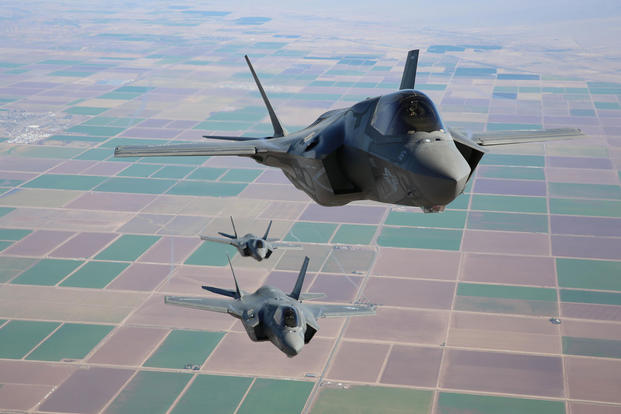The manager of the Pentagon's Joint Strike Fighter program said Monday he'll welcome the opportunity to sit down with president-elect Donald Trump and members of his new administration to address his public critique of the F-35.
Speaking to reporters at the F-35's Joint Program Office headquarters near Washington, D.C, Air Force Lt. Gen. Christopher Bogdan addressed Trump's Dec. 12 tweet that "F-35 program and cost is out of control." At a rally in Pennsylvania Dec. 15, Trump expanded on the remark, saying the Pentagon was making bad deals and that the "revolving door" trend of government employees who go on to take contracting and lobbying jobs was hurting efficiency.
"I have no doubt, given the controversy on the F-35 program over the years, that there is a perception that this program is out of control," Bogdan said.
"Six-year delay, thirteen-and-a-half billion-dollar overrun. The first F-35s cost twice as much as we thought they were going to. That's in the past," he added. "If given the opportunity, I would like to try to explain to the new administration that this is a vastly different program from 2011 on, and I'll just lay the facts out on the table and let them make their own judgments."
Bogdan made the remarks as he summarized how the F-35 program had fared in 2016. While the aircraft hit a series of major milestones, including initial operational capability for the F-35A Air Force variant; completion of at-sea testing for the F-35B Marine Corps and F-35C Navy variants; and delivery of F-35s to Italy and Israel, it has also seen setbacks, including unexpected delays and cost overruns.
An improved version of the F-35's Autonomic Logistics Information System software, or ALIS, expected to be delivered before the end of the year, is now likely delayed until this spring due to back-end software migration issues, Bogdan said.
The major milestone of getting 23 F-35s ready for Initial Operational Test and Evaluation, previously expected to begin in September, is now delayed six months.
And the F-35 System Development and Demonstration phase, originally planned for completion by the end of October 2017, is now expected to wrap up between November 2017 and May 2018, according to Defense Department estimates. This phase will also take another $532 million to complete, though Bogdan said $265 million of that money had been taken out of the program to fund other projects and now was owed back, and some $165 million was due to new requirements added in the last few years.
"It's not seven months delayed yet," Bogdan said of SDD. "Nobody knows how long it's going to be delayed."
If Bogdan could send one message to Trump, it would be that "this program is not out of control," he said.
"Since 2011, we have basically been on schedule. Since 2011, we have basically been on budget," he said. "We are delivering now today 50-plus airplanes a year that in the hands of the warfighter make a huge, huge difference."
But despite his advocacy for the program, Bogdan said he and the Joint Program Office have not coordinated with industry to counter Trump's messaging, nor do they plan to. His strategy, he said, was to tell the truth.
"I am not a salesman for the F-35," he said. "Our job is going to be to give the administration the good, the bad, and the ugly about this program and let them make their own decisions. What I will tell you is, I think that this program is vital for air dominance for us and our allies for the next 50 years. It replaces many, many, many legacy fleets. It has tremendous international participation and involvement. And it is a necessary program for the United States to maintain its security. And I will tell, if given the opportunity, that to the next administration."
For the F-35, significant challenges still lie ahead.
After more than a year of negotiation with contractor Lockheed Martin, the Pentagon in November decided to unilaterally contract for low-rate initial production (LRIP) lot 9 of the aircraft, a move immediately condemned by the company. In the new year, the two parties must negotiate for LRIP lot 10 of the aircraft, returning to negotiations at the "elemental level" to reach an agreed-upon price, Bogdan said.
While the Defense Department has not ruled out another unilateral action, Bogdan said he is hopeful of reaching a bilateral "handshake" deal for the aircraft that will see cost reductions of 6 to 7 percent for each aircraft variant.
-- Hope Hodge Seck can be reached at hope.seck@military.com. Follow her on Twitter at @HopeSeck.
Related Video:






























